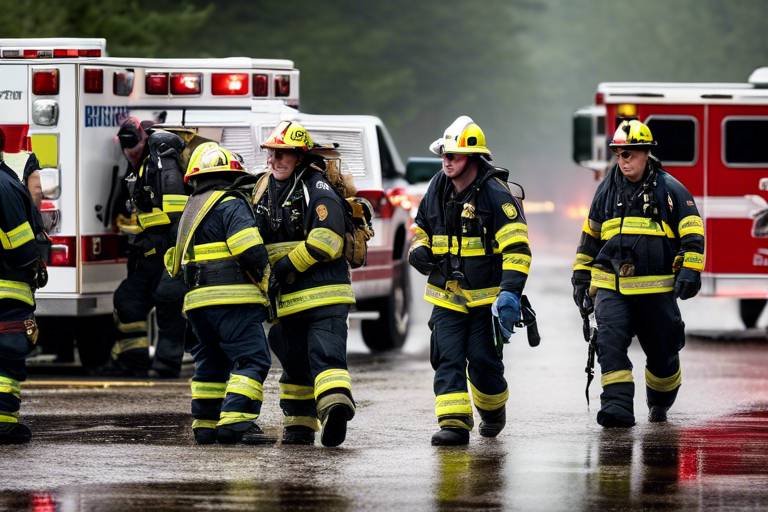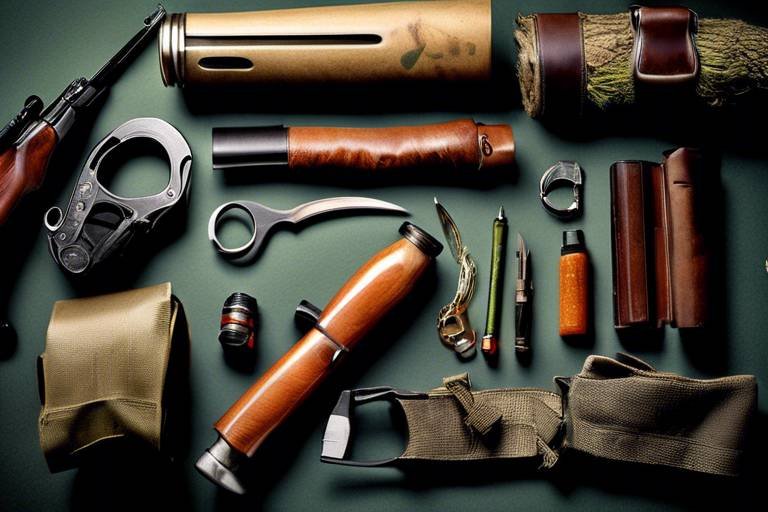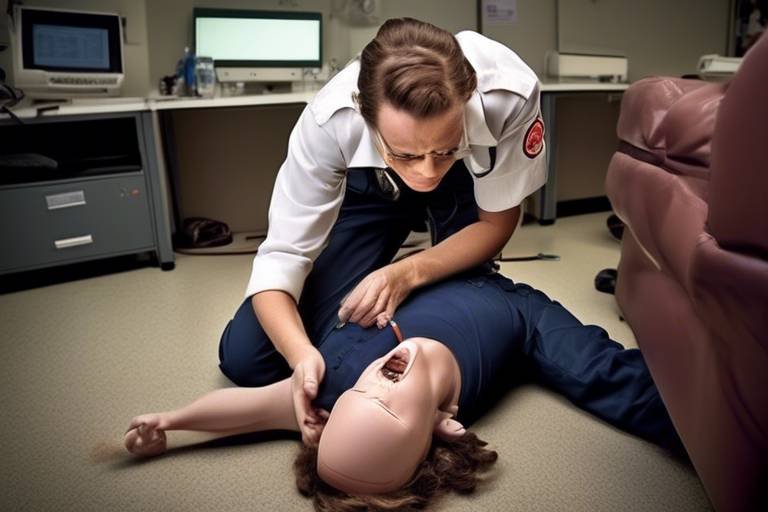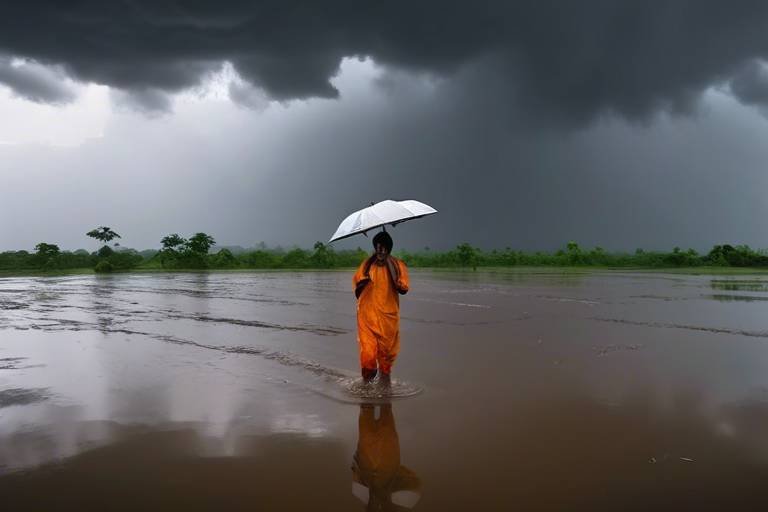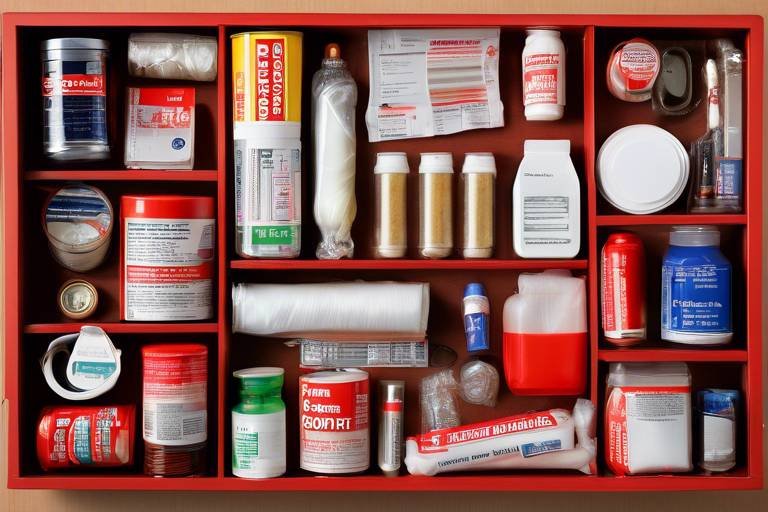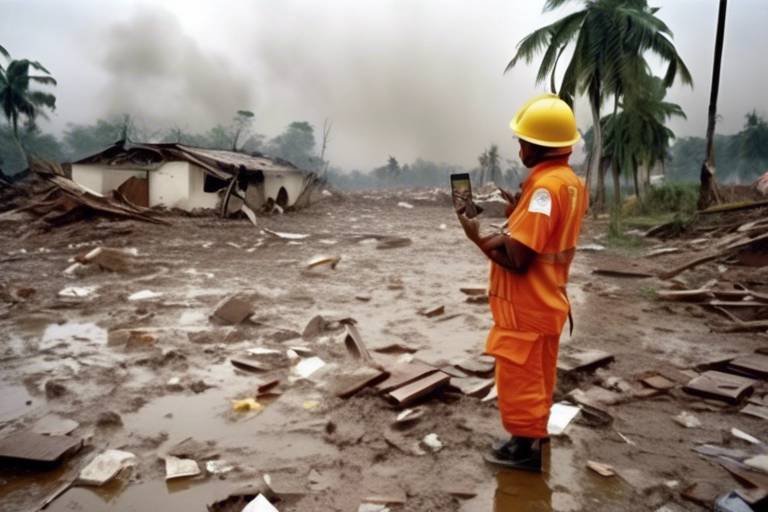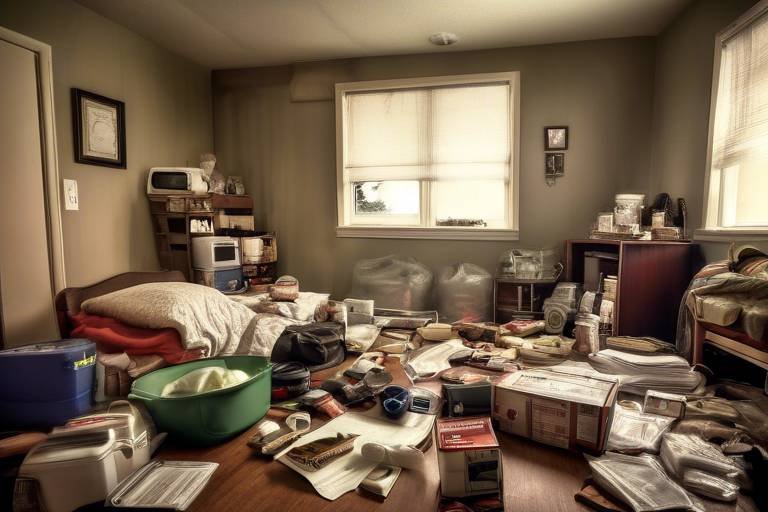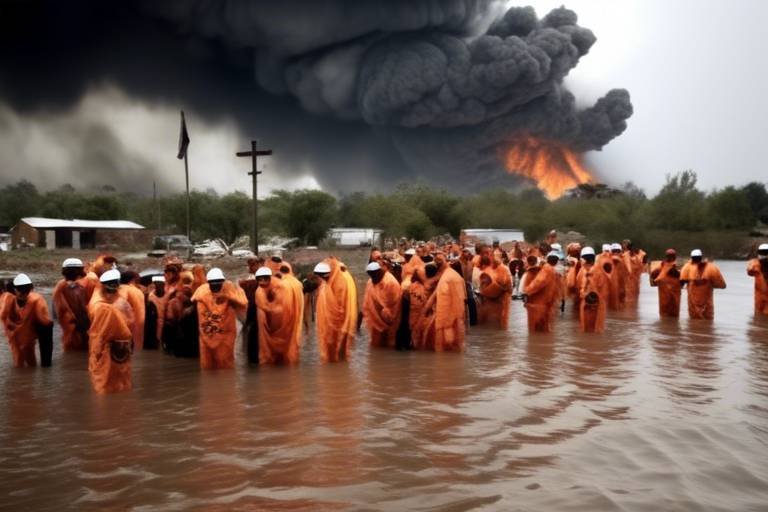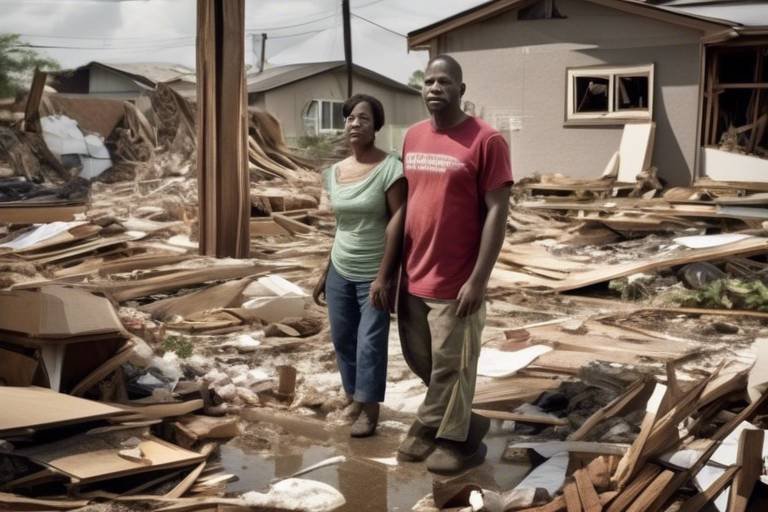Learn from the Pros – Emergency Preparedness Tips from First Responders
When it comes to emergencies, the insights from those who face crises head-on—our first responders—are invaluable. These brave individuals, whether they be firefighters, paramedics, or police officers, have been trained to handle unpredictable situations with precision and calmness. Their experiences can guide us in preparing ourselves and our families for the unexpected. So, let’s dive deep into the world of emergency preparedness and learn from the pros!
Emergency preparedness is more than just a buzzword; it’s a critical strategy for safeguarding your loved ones and property. Think of it as creating a safety net that catches you when life throws you a curveball. By planning ahead, you can significantly enhance your ability to respond effectively when crises arise. This proactive approach minimizes risks and ensures safety for you and those around you. Remember, it’s not about living in fear; it’s about living with confidence and resilience.
Imagine waking up one day to find your neighborhood in chaos—how would you react? This is where having a solid emergency plan comes into play. An effective emergency plan outlines the steps to take during various emergencies, such as natural disasters, medical emergencies, or even man-made threats. To create a comprehensive plan, consider the following:
- Communication Strategies: How will you communicate with family members during an emergency? Designate a meeting point and establish a communication tree.
- Evacuation Routes: Know multiple ways to exit your area. Familiarize yourself with local roads and potential obstacles.
- Essential Contacts: Keep a list of important contacts, including family, friends, and local emergency services.
By ensuring that everyone is informed and prepared, you can navigate emergencies with greater ease and confidence.
One of the first steps in preparing for emergencies is understanding the specific risks in your region. Are you in a flood zone? Is your area prone to wildfires or earthquakes? Knowing these risks is crucial because it allows you to tailor your emergency plan accordingly. Assess local hazards by checking with community organizations and government resources. This knowledge empowers you to take proactive steps rather than waiting for disaster to strike.
There are various resources available to help you understand local risks better. Government websites often provide detailed information on natural disasters and emergency preparedness. Additionally, community organizations can offer insights into specific threats in your area. Here are a few resources you might find useful:
| Resource | Description |
|---|---|
| Ready.gov | A comprehensive site for emergency preparedness information. |
| Local Fire Department | Offers resources on fire safety and local hazards. |
| Community Emergency Response Teams (CERT) | Provides training and information on community risks. |
Engaging with your community can significantly enhance your emergency preparedness. Participating in local emergency preparedness programs not only enriches your knowledge but also fosters a sense of camaraderie. When communities come together, they become stronger and more resilient. Collective efforts can make a world of difference during disasters, as neighbors look out for each other and share resources.
Imagine being caught in a storm with no supplies—sounds terrifying, right? That’s why a well-stocked emergency kit is essential for survival during a crisis. Your emergency kit should include items that cater to your family’s specific needs, such as:
- Water (one gallon per person per day for at least three days)
- Non-perishable food (enough for at least three days)
- First aid supplies
- Flashlights and batteries
By preparing this kit ahead of time, you ensure that you have the necessary supplies to last through various emergencies, giving you peace of mind when it matters most.
Regular training and drills are essential components of emergency preparedness. It’s one thing to have a plan, but it’s another to practice it. Engaging in drills helps reinforce your emergency plan and builds muscle memory, so when the time comes to act, you do so without hesitation. Consider seeking out training opportunities that can improve your response skills.
Having first aid and CPR skills can truly save lives during emergencies. Imagine being in a situation where someone is in dire need of help—your training could make all the difference. Obtaining certification not only equips you with the skills to assist others but also empowers you to act confidently in critical situations. Many local organizations offer courses, so it’s worth checking out what’s available in your area.
Participating in community drills enhances preparedness and fosters teamwork. These exercises simulate real-life scenarios, allowing you to practice your response in a controlled environment. Engaging in local emergency exercises helps you become familiar with the protocols and strengthens your readiness for real-life situations. Plus, it’s a great way to meet neighbors and build a support network!
In the world of emergency preparedness, knowledge is power. Staying informed about potential emergencies and response options is vital. Accessing reliable information sources, such as local news updates and community resources, can keep you ahead of the curve. Sign up for alerts from local emergency management agencies to stay updated on any threats that may arise. Remember, being informed is your first line of defense!
Q: What should I include in my emergency kit?
A: Your emergency kit should have essentials like water, non-perishable food, first aid supplies, a flashlight, batteries, and any personal medications.
Q: How often should I review my emergency plan?
A: It’s a good idea to review your emergency plan at least once a year or whenever there are significant changes in your family or living situation.
Q: Where can I find local emergency preparedness resources?
A: Check government websites, local fire departments, and community organizations for resources tailored to your area.
By taking these proactive steps and learning from the experiences of first responders, you can ensure that you and your loved ones are well-prepared for any emergency that may come your way.

Understanding Emergency Preparedness
Emergency preparedness is not just a buzzword; it’s a crucial aspect of our daily lives that can mean the difference between chaos and calm when disaster strikes. Imagine you're at home, and suddenly the ground shakes beneath you. What do you do? How do you ensure the safety of your family? This is where preparedness comes into play. It involves a series of proactive steps that individuals and families can take to prepare for potential emergencies, ranging from natural disasters like hurricanes and earthquakes to man-made crises such as chemical spills or active shooter situations.
Understanding the importance of emergency preparedness is essential. It’s about being ready to respond effectively to crises, minimizing risks, and ensuring safety for you and your loved ones. When you take the time to prepare, you’re not just protecting yourself; you’re also empowering your community. Think of it as building a safety net. The stronger the net, the less likely you are to fall through the cracks when trouble comes knocking.
So, what does effective emergency preparedness look like? Here are some key components:
- Planning: This involves creating a comprehensive emergency plan that outlines your family’s response to various situations. It should include communication strategies, evacuation routes, and essential contacts.
- Training: Regular training and drills help reinforce your emergency plan and improve your response skills. Knowing what to do in a crisis can save lives.
- Resources: Understanding local risks and having the right resources at your disposal can make all the difference. This includes having a well-stocked emergency kit and access to reliable information sources.
Emergency preparedness is not a one-time event but an ongoing process. It requires regular updates and evaluations of your plan as circumstances change. For instance, if you move to a new area, it’s essential to reassess the risks that may be present in your new environment. Are you living in a flood zone? Is there a history of wildfires in the region? Knowing these factors can help you tailor your emergency plan effectively.
Moreover, engaging with your community is a vital aspect of preparedness. When individuals come together to share knowledge, resources, and support, the entire community becomes more resilient. Participating in local emergency preparedness programs can provide valuable insights and foster a sense of camaraderie among neighbors, making it easier to respond collectively when emergencies arise.
In summary, understanding emergency preparedness is about more than just having a plan; it’s about creating a culture of safety and resilience. By taking proactive steps today, you can ensure that you and your loved ones are ready to face whatever challenges may come your way. Remember, when it comes to emergencies, it’s always better to be prepared than to be caught off guard!

Creating an Emergency Plan
Creating an emergency plan is like drawing a map before embarking on a journey through uncharted territory. It’s not just a good idea; it’s a necessity that can make all the difference when chaos strikes. Imagine you’re in the midst of a storm, and you suddenly realize you don’t know where to go or what to do. Panic sets in, and your chances of ensuring safety diminish rapidly. This is why having a well-thought-out plan is crucial; it provides a clear path to follow when every second counts.
Your emergency plan should be as unique as your family. Start by identifying the different types of emergencies that could potentially affect you. These could range from natural disasters like hurricanes and earthquakes to man-made events such as fires or chemical spills. Once you have a grasp on the possible scenarios, you can tailor your plan to address these specific risks. For instance, if you live in an area prone to flooding, your plan should include evacuation routes that steer clear of waterlogged zones.
Next, communication is key. Ensure that every member of your household knows how to reach each other during an emergency. Create a list of important contacts, including family members, friends, and local emergency services. This list should be easily accessible; consider keeping a printed copy in your emergency kit as well as digital versions on your phones. Additionally, establish a family meeting point where everyone can gather if you get separated. This could be a neighbor’s house, a local park, or any easily recognizable location.
Incorporating the use of technology can also enhance your emergency plan. Today’s smartphones come equipped with apps that provide real-time alerts and updates on emergencies in your area. Make sure to download these apps and familiarize yourself with their features. Some can even send notifications about weather changes or local emergencies, keeping you one step ahead.
Lastly, don’t forget to involve everyone in the planning process. This not only ensures that everyone is on the same page but also empowers each family member to take ownership of their safety. Hold a family meeting to discuss the plan, and encourage questions and suggestions. This collaborative approach can make the process more engaging and less intimidating. After all, an emergency plan is not just a document; it’s a lifeline that can guide you through the storm.
By taking these steps to create a comprehensive emergency plan, you’re not just preparing for the worst; you’re instilling a sense of security and resilience within your family. Remember, the best time to prepare is before an emergency occurs. So, roll up your sleeves, gather your loved ones, and start crafting a plan that will keep you safe when it matters most.

Identifying Risks in Your Area
When it comes to emergency preparedness, one of the most critical steps is identifying the risks in your area. Imagine you're a ship captain navigating through treacherous waters; knowing the hidden reefs and stormy patches can mean the difference between safe passage and disaster. Similarly, understanding the specific hazards that could affect your locality is essential to crafting an effective emergency plan.
Every region has its unique set of risks, influenced by geography, climate, and even local infrastructure. For instance, if you live in a coastal area, you might be more vulnerable to hurricanes and flooding. On the other hand, those in the Midwest may need to prepare for tornadoes or severe winter storms. To get started, consider conducting a thorough risk assessment of your surroundings. This involves looking into:
- Natural Disasters: Earthquakes, floods, wildfires, and hurricanes.
- Man-Made Threats: Industrial accidents, terrorism, and chemical spills.
- Health Emergencies: Pandemics or widespread illness outbreaks.
To effectively assess these risks, you can utilize various resources that provide detailed information about local hazards. Government websites, such as those from the Federal Emergency Management Agency (FEMA) or your state’s emergency management office, often have comprehensive data on potential threats. Additionally, local community organizations may offer insights into specific risks that might not be widely known.
Moreover, engaging with your neighbors can be incredibly beneficial. They might have personal experiences or knowledge about past emergencies that can inform your understanding of local risks. Hosting community meetings or discussions can foster an environment where everyone shares their insights, creating a more robust safety net for all. Remember, preparedness is not just an individual effort; it's a collective one. By pooling together knowledge and resources, your community can enhance its resilience against emergencies.
In conclusion, identifying the risks in your area is a proactive step that lays the groundwork for effective emergency preparedness. By understanding what threats you may face, you can tailor your emergency plan to address these challenges head-on, ensuring that you and your loved ones are ready for whatever comes your way.

Resources for Risk Assessment
When it comes to emergency preparedness, understanding the specific risks your community faces is crucial. Fortunately, there are numerous resources available to help you assess these risks effectively. These resources can guide you in identifying potential hazards, whether they are natural disasters like earthquakes and floods, or man-made threats such as chemical spills or terrorism. By utilizing these tools, you can tailor your emergency plan to address the unique challenges of your area.
One of the best starting points for risk assessment is your local government’s emergency management office. Many municipalities have dedicated websites that provide information on local hazards, emergency response plans, and resources for residents. These sites often include maps that highlight flood zones, earthquake fault lines, and other critical data that can help you understand the risks in your neighborhood.
In addition to government resources, community organizations play a pivotal role in risk assessment. Organizations such as the Red Cross offer valuable information on emergency preparedness and response. They often conduct workshops and training sessions that can help you and your family understand local risks and how to mitigate them. Participating in these programs not only enhances your knowledge but also connects you with other community members who share your commitment to safety.
Furthermore, social media platforms and local news outlets can be excellent sources of information. Many cities have dedicated emergency management accounts on platforms like Twitter and Facebook, where they post real-time updates about potential threats and preparedness tips. Staying engaged with these channels can keep you informed about any developing situations that may affect your safety.
Lastly, consider joining local emergency preparedness groups or forums. These platforms often share firsthand experiences and insights from residents who have faced various emergencies. By tapping into the collective knowledge of your community, you can gain a deeper understanding of the risks you might encounter and the best strategies to prepare for them.
In summary, effective risk assessment is the foundation of a solid emergency preparedness plan. By leveraging local government resources, community organizations, social media, and peer networks, you can gain comprehensive insights into the hazards specific to your area. This proactive approach not only enhances your safety but also contributes to the overall resilience of your community.
- What should I include in my emergency kit? Your emergency kit should include essentials like water, non-perishable food, a flashlight, batteries, a first aid kit, and any necessary medications.
- How often should I review my emergency plan? It's recommended to review your emergency plan at least once a year or whenever there are significant changes in your household or community.
- How can I get involved in local emergency preparedness programs? Check with your local emergency management office or community organizations for opportunities to volunteer or participate in training sessions.
- What are the most common natural disasters in my area? The most common natural disasters vary by region; consult local resources or emergency management offices for specific information.

Community Involvement
Engaging with your community is not just a good idea; it's a crucial element of effective emergency preparedness. Think of your community as a safety net; when everyone is involved, the net becomes stronger, providing better support during crises. By participating in local emergency preparedness programs, you not only equip yourself with essential skills but also foster a sense of unity and resilience among your neighbors. Imagine a neighborhood where everyone knows their role during a disaster—how much more secure would you feel?
One of the most significant advantages of community involvement is the sharing of resources. When individuals come together, they can pool their knowledge, skills, and materials, creating a more comprehensive and effective emergency response plan. For instance, local workshops can teach valuable skills like first aid or CPR, and community drills can simulate real-life scenarios, helping everyone to be better prepared. By participating in these activities, you also build relationships that can be invaluable during an actual emergency.
Moreover, engaging with local organizations can provide you with insights into specific risks that your community faces. For example, you might learn about flood zones, fire hazards, or even the best evacuation routes. This information is vital, as it allows you to tailor your emergency plan to address the unique challenges of your area. also opens up channels for communication. When emergencies strike, having a network of informed neighbors can make all the difference in ensuring that everyone stays safe and accounted for.
In addition, many communities have established emergency response teams or volunteer groups dedicated to disaster preparedness. Joining one of these teams can provide hands-on experience and training, making you a more effective responder when it counts. It’s like being part of a superhero squad—everyone has different strengths, and together, you can tackle any challenge that comes your way.
In conclusion, community involvement is a powerful tool in emergency preparedness. It creates a web of support, enhances communication, and equips everyone with the knowledge and skills needed to respond effectively. So, why not take that first step? Attend a local meeting, volunteer for a community event, or simply start a conversation with your neighbors about emergency preparedness. Together, you can build a safer, more resilient community.

Building an Emergency Kit
When it comes to emergencies, having a well-stocked emergency kit can be the difference between chaos and calm. Imagine facing a sudden storm or an unexpected power outage without the essentials at your fingertips. It’s a bit like going on a road trip without a map—you might make it eventually, but the journey will be a lot smoother if you’re prepared. So, what exactly should you include in your emergency kit? Well, let’s break it down.
Your emergency kit should be tailored to your specific needs and the types of emergencies you might face. Start with the basics: water and food. The general rule of thumb is to have at least one gallon of water per person per day for at least three days, along with a supply of non-perishable food items that can last just as long. Think canned goods, energy bars, and dried fruits. These are not only easy to store but also provide the necessary nutrition when you need it most.
Next, consider adding essential items that cater to your family's unique needs. For example, if you have infants or pets, don’t forget their supplies. A well-rounded kit might include:
- First Aid Kit: This should contain band-aids, antiseptic wipes, pain relievers, and any personal medications.
- Flashlights and Batteries: Power outages can happen without warning, so having a reliable flashlight and extra batteries is crucial.
- Multi-tool or Swiss Army Knife: This handy gadget can assist in various situations, from opening cans to making repairs.
- Whistle: In case you need to signal for help, a whistle can carry much farther than your voice.
Don’t forget about important documents! Keep copies of your identification, insurance policies, and medical records in a waterproof container. This way, you can ensure that you have access to crucial information when you need it most.
Lastly, it’s a great idea to regularly check your emergency kit. Just like a car needs maintenance, your kit needs to be refreshed. Make it a habit to review your supplies every six months—replace expired food and medications, and ensure everything is in working order. After all, an emergency kit is only as good as its contents!
Q: How often should I check my emergency kit?
A: It's advisable to check your emergency kit at least twice a year to replace expired items and ensure everything is functional.
Q: How much water should I store?
A: Aim for at least one gallon of water per person per day for a minimum of three days, which totals about 12 gallons for a family of four.
Q: Can I use a regular backpack for my emergency kit?
A: Absolutely! A sturdy backpack is a great option for your emergency kit, making it easy to carry if you need to evacuate quickly.
Q: What if I have special medical needs?
A: Be sure to include any necessary medications, medical supplies, and a list of your medical conditions and allergies in your kit.

Training and Drills
Regular training and drills are the backbone of effective emergency preparedness. Think of it like a sports team practicing for a championship game; without consistent practice, the players may falter when it truly counts. Just as athletes refine their skills to perform under pressure, individuals and communities must engage in drills to ensure they can act swiftly and efficiently during a crisis. By simulating emergency scenarios, you not only familiarize yourself with your emergency plan but also build confidence in your ability to respond. This practice can mean the difference between chaos and calm when disaster strikes.
One of the most significant benefits of conducting regular drills is the opportunity to identify gaps in your emergency plan. Perhaps during a drill, you realize that your evacuation route is blocked or that your family members are unsure of their roles. These insights allow you to make necessary adjustments, ensuring that your plan is as effective as possible. Additionally, practicing as a group fosters a sense of teamwork and solidarity, which can be incredibly reassuring in times of stress.
Moreover, seeking out training opportunities can further enhance your preparedness. Many local organizations offer courses in first aid, CPR, and emergency response techniques. These skills are invaluable, as they not only help you take care of yourself but also empower you to assist others in need. Imagine being in a situation where someone collapses; having the skills to perform CPR could mean saving a life. The confidence that comes from knowing you are equipped to handle emergencies cannot be overstated.
Participating in local drills is another excellent way to bolster your emergency preparedness. Many communities host emergency response exercises that simulate real-life scenarios. Engaging in these drills not only enhances your individual readiness but also strengthens community bonds. When everyone is on the same page, the community can respond more effectively as a cohesive unit. This collective effort is crucial during actual emergencies, where every second counts.
To summarize, training and drills are essential components of emergency preparedness. They provide opportunities for practice, enhance individual skills, and foster community collaboration. So, gather your family, reach out to local organizations, and start practicing today. Remember, the more prepared you are, the more resilient you will be when faced with unexpected challenges.
- How often should I conduct emergency drills? It's recommended to conduct drills at least twice a year to keep everyone familiar with the plan.
- Where can I find local training opportunities? Check with your local Red Cross, fire department, or community center for available courses.
- What should I do if I can't participate in a drill? If you can't attend, make sure to review the emergency plan with your family and practice it individually.

First Aid and CPR Training
When it comes to emergencies, having First Aid and CPR training can be the difference between life and death. Imagine being in a situation where someone collapses in front of you. Panic sets in, but what if you had the skills to step in and help? This is where the importance of these training programs shines. Not only do they equip you with the knowledge to respond effectively, but they also empower you to act with confidence when every second counts.
First Aid training covers a wide range of skills, from treating minor injuries like cuts and bruises to managing more severe situations such as fractures or allergic reactions. It teaches you how to assess a situation, provide care, and when to seek professional help. Meanwhile, CPR (Cardiopulmonary Resuscitation) is a lifesaving technique used in emergencies when someone's breathing or heartbeat has stopped. Learning CPR can be incredibly empowering, as it enables you to potentially save a life until emergency services arrive.
Many organizations, including the American Red Cross and the National Safety Council, offer comprehensive courses that combine both First Aid and CPR training. These courses often include practical, hands-on experience, which is crucial for mastering the techniques. By participating in these classes, you not only learn the skills but also practice them in a controlled environment, which can significantly boost your confidence.
Moreover, obtaining certification in First Aid and CPR is not just a personal achievement; it can also enhance your professional profile. Many employers value employees who are trained in these areas, especially in fields such as healthcare, education, and emergency services. This certification can even be a requirement for certain jobs, making it a worthwhile investment in your future.
To give you a clearer idea of what you can learn in these training sessions, here’s a brief overview of essential skills typically covered:
| Skill | Description |
|---|---|
| CPR Techniques | Learn how to perform chest compressions and rescue breaths effectively. |
| Choking Relief | Understand the steps to take if someone is choking, including the Heimlich maneuver. |
| Wound Care | Gain knowledge on how to clean and dress wounds to prevent infection. |
| Shock Management | Identify the signs of shock and learn how to manage it until help arrives. |
In addition to formal training, practicing these skills regularly is essential. Just like any other skill, the more you practice, the more proficient you become. Consider organizing practice sessions with friends or family members who are also trained. This not only reinforces your skills but also creates a supportive environment where everyone can learn and grow together.
In conclusion, investing time in First Aid and CPR training is a powerful way to prepare yourself for emergencies. It’s not just about knowing what to do; it’s about being ready to take action when it matters most. So why wait? Sign up for a class today and equip yourself with the skills that could save a life!
- What is the difference between First Aid and CPR? First Aid refers to the initial care provided for an injury or illness, while CPR specifically focuses on restoring breathing and circulation.
- How long does First Aid and CPR training take? Most courses range from a few hours to a full day, depending on the depth of training.
- Is certification necessary? While not always required, certification can be beneficial for personal knowledge and professional opportunities.
- Can I take First Aid and CPR training online? Yes, many organizations offer online courses, but practical hands-on training is highly recommended for skill mastery.

Participating in Local Drills
When it comes to emergency preparedness, participating in local drills is like hitting the gym for your safety muscles. Just as you wouldn’t expect to run a marathon without training, you can’t hope to respond effectively in a crisis without practicing your emergency plan. Local drills are not just boring rehearsals; they are dynamic, engaging, and invaluable opportunities to test your readiness. Imagine being part of a team, working together to navigate through simulated emergencies, and feeling that rush of adrenaline as you put your skills to the test. It's not just about knowing what to do; it's about feeling confident in your ability to act when it truly matters.
Engaging in these drills offers several benefits. Firstly, they help you familiarize yourself with emergency procedures, making them second nature. You’ll learn how to communicate effectively with first responders, understand evacuation routes, and even discover the best ways to assist others in distress. It’s like learning a dance routine—once you know the steps, you can perform them without thinking. Plus, participating in these drills fosters a sense of community. You’ll connect with neighbors and local organizations, building relationships that can be crucial during an actual emergency.
Moreover, local drills often simulate various scenarios, from natural disasters like earthquakes and floods to man-made emergencies such as fires or hazardous material spills. This variety ensures that you are not just prepared for one type of emergency but are equipped to handle multiple situations. Think of it as a buffet of preparedness skills—each drill adds a new dish to your plate, enriching your overall readiness.
To give you a clearer picture of what to expect, here’s a brief overview of typical components of a local drill:
| Drill Component | Description |
|---|---|
| Scenario Simulation | Participants react to a simulated emergency situation, practicing their response in real-time. |
| Communication Exercises | Focus on how to relay information effectively between team members and first responders. |
| Evacuation Procedures | Practice safe exit routes and assembly points to ensure everyone knows where to go. |
| First Aid Stations | Learn basic first aid skills, reinforcing the importance of medical assistance during emergencies. |
As you can see, participating in local drills is not just an activity; it’s an essential part of emergency preparedness that can save lives. So, the next time you hear about a local drill, don’t hesitate to sign up. Bring your family, encourage your friends, and make it a community affair. After all, when we prepare together, we can face any challenge that comes our way!
- What should I wear to a local drill? It's best to wear comfortable clothing and sturdy shoes, as you may be moving around a lot.
- Do I need to register in advance? Some drills may require registration, so check with your local emergency management office.
- Can children participate in local drills? Yes! Many drills are family-friendly and include activities for kids to learn about safety.
- What if I have mobility issues? Drills are designed to accommodate everyone, and there are often modifications available for those with mobility challenges.

Staying Informed
In today’s fast-paced world, staying informed about potential emergencies is more crucial than ever. Imagine waking up to a weather alert or a sudden evacuation notice. How would you react? Would you be ready to spring into action, or would you find yourself scrambling for information? Being well-informed can make all the difference in how you respond to crises. It’s like having a map when you’re lost in unfamiliar territory—without it, you’re just wandering aimlessly.
To effectively prepare for emergencies, you need to tap into reliable sources of information. This isn't just about listening to the news; it’s about knowing where to find timely updates and alerts. Here are some essential resources to consider:
- Local News Outlets: Television stations and radio channels often provide real-time updates during emergencies.
- Emergency Management Agencies: Websites of local and state emergency management offices are treasure troves of information regarding hazards and preparedness tips.
- Social Media: Follow local authorities on platforms like Twitter and Facebook for immediate alerts and updates.
- Mobile Apps: Consider downloading emergency alert apps that provide notifications tailored to your location.
Additionally, it’s wise to sign up for community alert systems. These systems send text messages or emails about emergencies in your area, ensuring you receive critical information without delay. Think of it as having a personal assistant who whispers urgent updates in your ear, keeping you one step ahead.
But being informed goes beyond just receiving alerts. It’s also about understanding the nature of the threats you might face. For instance, if you live in an area prone to hurricanes, familiarize yourself with the local evacuation routes and shelters. If wildfires are a concern, know the signs of danger and how to respond. This knowledge empowers you to make informed decisions quickly, rather than relying on others to guide you in the heat of the moment.
Moreover, engaging with your community can enhance your information network. Attend local meetings, participate in neighborhood watch programs, or join community preparedness groups. These interactions not only keep you informed but also foster a sense of camaraderie and collective responsibility. When everyone is on the same page, the entire community becomes more resilient.
| Resource Type | Examples | Benefits |
|---|---|---|
| Local News | TV, Radio | Real-time updates during emergencies |
| Government Websites | FEMA, Local Emergency Management | Comprehensive preparedness information |
| Social Media | Twitter, Facebook | Immediate alerts and community updates |
| Mobile Apps | Weather Alerts, Emergency Notifications | Personalized alerts based on location |
In conclusion, staying informed is not just about gathering information; it's about creating a proactive approach to emergencies. By utilizing various resources, engaging with your community, and continuously educating yourself about potential risks, you can enhance your preparedness and ensure the safety of yourself and your loved ones. Remember, knowledge is power, and in the face of emergencies, that power is invaluable.
Q1: How can I stay updated on emergency alerts?
A1: You can stay updated by following local news outlets, signing up for community alert systems, and downloading emergency alert apps.
Q2: What should I do if I receive an emergency alert?
A2: Follow the instructions provided in the alert, assess your situation, and take necessary actions such as evacuating or seeking shelter.
Q3: How can community involvement improve emergency preparedness?
A3: Engaging with your community fosters teamwork, enhances information sharing, and strengthens collective resilience during disasters.
Frequently Asked Questions
- What is emergency preparedness?
Emergency preparedness is all about being ready for unexpected situations, like natural disasters or other crises. It involves having a plan in place, knowing what to do, and having the right supplies to keep you and your loved ones safe.
- Why is it important to create an emergency plan?
Creating an emergency plan is crucial because it helps you respond quickly and effectively during a crisis. When everyone knows their roles and the steps to take, it reduces panic and confusion, ultimately saving lives.
- How do I identify risks in my area?
You can identify risks by researching local hazards such as floods, earthquakes, or fires. Check government websites, community resources, and talk to neighbors to understand the specific threats you might face.
- What should I include in my emergency kit?
Your emergency kit should have essentials like water, non-perishable food, a flashlight, first aid supplies, and important documents. Tailor it to your family's needs, adding things like medications or baby supplies if necessary.
- How often should I practice my emergency plan?
It's a good idea to practice your emergency plan at least twice a year. Regular drills help everyone remember what to do and can highlight any areas that need improvement before a real emergency occurs.
- Where can I find first aid and CPR training?
You can find first aid and CPR training through local hospitals, community centers, or organizations like the Red Cross. Many places offer online courses, which can be a convenient option for busy schedules.
- How can I stay informed about emergencies?
Staying informed involves subscribing to local news alerts, following community social media pages, and signing up for emergency notification systems. Being proactive about information can help you react quickly when needed.
- What role does community involvement play in emergency preparedness?
Community involvement is vital because it builds a network of support. When neighbors work together, share resources, and participate in local drills, everyone becomes more resilient and better prepared for emergencies.

